Home
/ About Egypt / Abu Simbel
Abu Simbel

Created: Dec 24, 2009,
modified: Jan 13, 2012,
overall rating: 0.000
Ybsambul was already legendary to a degree. On March 22, 1813 Johann Ludwig Burckhardt, a Swiss historian known as Ibrahim Ibn Abdallah to the Arabs, landed on the shores of the Mile accompanied by the local guide Saad with the intention of visiting the temple dedicated to Nefertari, the beautiful and beloved wife of the Pharaoh, convinced that Ybsambul had no other ancient attractions to offer.
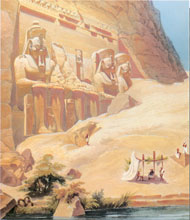 Whereupon he proceeded to climb the sandy slope "... when by chance I took a few too many steps towards the south, and my glance fell on what was still visible of four colossal statues cut into the rock". The wind, blowing fiercely into the gorge, had pushed and piled up a mass of dozens of meters of sand against the stone giants so that only part of the heads emerged, and Burckhardt was uncertain whether the statues were standing or seated. Abu Simbel, the mythical Ybsambum, had been found.
Whereupon he proceeded to climb the sandy slope "... when by chance I took a few too many steps towards the south, and my glance fell on what was still visible of four colossal statues cut into the rock". The wind, blowing fiercely into the gorge, had pushed and piled up a mass of dozens of meters of sand against the stone giants so that only part of the heads emerged, and Burckhardt was uncertain whether the statues were standing or seated. Abu Simbel, the mythical Ybsambum, had been found. Only a few years later on August 1, 1817 another adventurer - the most adventurous of all, Giovanni Battista Belzoni -managed to free the upper part of the door from the sand and discover the entrance. After eleven centuries of oblivion, the architectural masterpiece and personal achievement of Ramses the Great was being violated by a European. After Belzoni's discovery many travelers faced the discomforts of the Nubian Desert, determined to reach Abu Simbel.
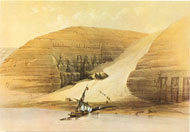 All were stuck by the sudden appearance of the gigantic awe-inspiring sculptures that seemed to emerge from the sand for some prodigious and supernatural event. Scholars also arrived; among the most eminent were: the Itali. Ippolito Rosellini and Salvatore Cherubi the French draftsman, Nestor l'Hote; Fn Champollion, who wrote that this tempi alone was worth a trip through the Nubi Desert; the German archaeologist Heinr: Schliemann, who had discovered entire such as Troy, Mycenae, and Tiryns, and defined it as "the world's most powerful of art". Once the facade of the temple v completely free of sand, visitors could e with greater ease, and without threat of finding the exit blocked with sand from minute to the next. The temple of Abu Simbel could at last be admired in all it beauty and complexity of concept.
All were stuck by the sudden appearance of the gigantic awe-inspiring sculptures that seemed to emerge from the sand for some prodigious and supernatural event. Scholars also arrived; among the most eminent were: the Itali. Ippolito Rosellini and Salvatore Cherubi the French draftsman, Nestor l'Hote; Fn Champollion, who wrote that this tempi alone was worth a trip through the Nubi Desert; the German archaeologist Heinr: Schliemann, who had discovered entire such as Troy, Mycenae, and Tiryns, and defined it as "the world's most powerful of art". Once the facade of the temple v completely free of sand, visitors could e with greater ease, and without threat of finding the exit blocked with sand from minute to the next. The temple of Abu Simbel could at last be admired in all it beauty and complexity of concept. The facade, sculpted into the live rock of the mountain, is 38 meters long and 31 meters high. The four colossal satues of the Pharaoh seated on his throne serve as supporting columns and are twenty meters high, more than four meters from ear to ear, and more than one along the line of the mouth. Within the accepted canons of monumental imagery, they reproduced an exact likeness of the sovereign.
The facade, sculpted into the live rock of the mountain, is 38 meters long and 31 meters high. The four colossal satues of the Pharaoh seated on his throne serve as supporting columns and are twenty meters high, more than four meters from ear to ear, and more than one along the line of the mouth. Within the accepted canons of monumental imagery, they reproduced an exact likeness of the sovereign.Penetrating to the heart of the mountain, an enormous hall appears in which eight ten-meter high pillars placed in two rows incorporate the figure of Osiris with the semblance of Ramses. Sixty-five meters within the temple in the sacrarium, Ramses II, himself ranked with the gods, sat at the gathering of the divine triad with Amon-Ra, Ptah, and Harmakhis. The inner walls depict Ramses' military achievements in a richly decorative relief series based on the long epic poem recounting the Pharaoh's victorious expedition in Syria, composed by Pentaur, the court-poet.
Ramses, however, not only built an edifice for his own eternal glorification; next to the Great Temple he built a much smaller one, barely 10 meters high, dedicated to his wife Nefertari, the favored and most beloved of his consorts. Never before in the history of Egypt had an image of the Pharaoh's wife appeared next to his, and of equal height, on the front of a temple. The new honor was bestowed on the Great Royal Bride, Nefertari-mery en Mut, the "Beloved of Mut". For her the Pharaoh had a temple "of fine, solid and white stone" cut into the rock; for her he had two ten-meter-high statues sculpted portraying her as Hathor with the horns of the sacred cow, the solar disc and two plumes.
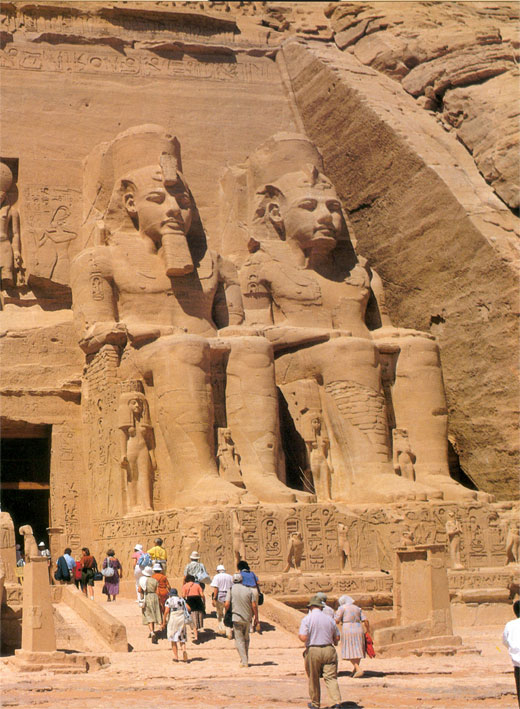
Documents
The Visit
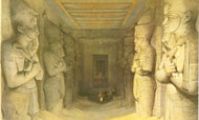
The cut-rock temple of Abu Simbel is actually nothing but the transferral into rock of the architectural elements of the ...
Visit into the interior

From the blinding light of day we now pass into the interior where the half light creates a mysterious evocative ...
The temple of Hathor
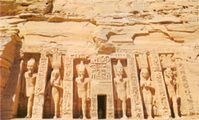
Despite appearances, Abu Simbel is more than simply a matter of Ramses II glorifying himself. It suffices to leave the ...
The Sacrarium

Sixty-five meters from the entrance portal, in the heart of the mountain, is the sacrarium, the most intimate and secret ...
Your Rating:
Overall rating: 0.000
Totally voted: 0
Comments
Login/Registration
Weather in:
Exchange Rates
1 USD = 16.200 LE
1 EUR = 18.040 LE
Section news
-
Sunrise in the Abu Simbel sanctuary
Feb 23, 2011, rating: 0.000, 0 votes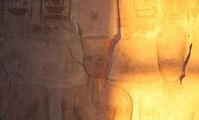 Outside the Great Temple of Abu Simbel, a long line of people are waiting for a first chance to glimpse ...
Outside the Great Temple of Abu Simbel, a long line of people are waiting for a first chance to glimpse ...








